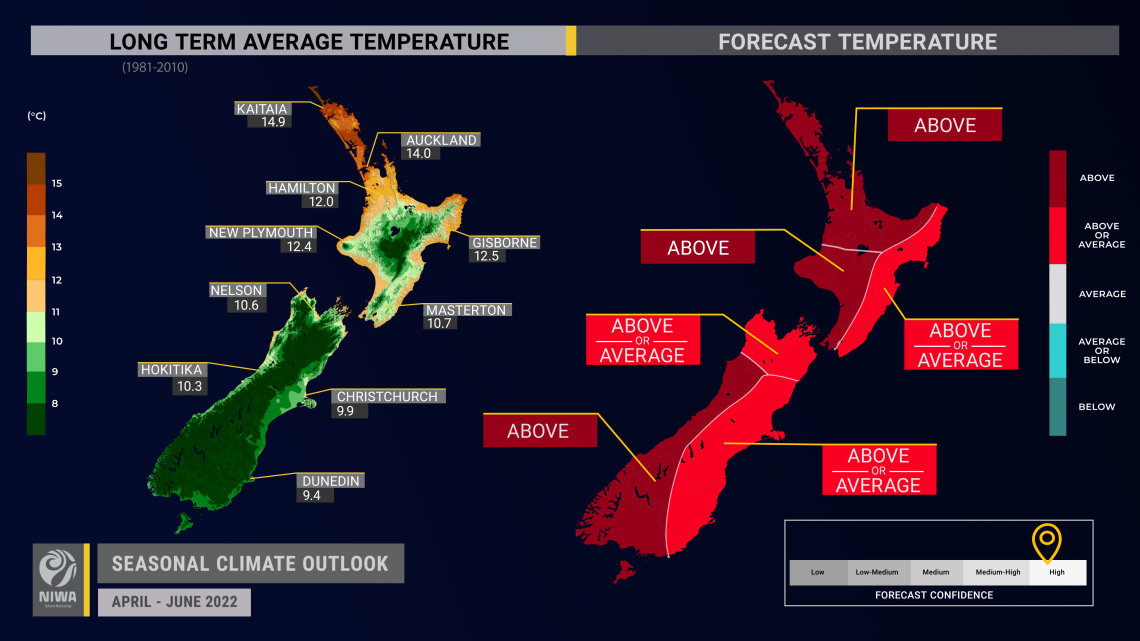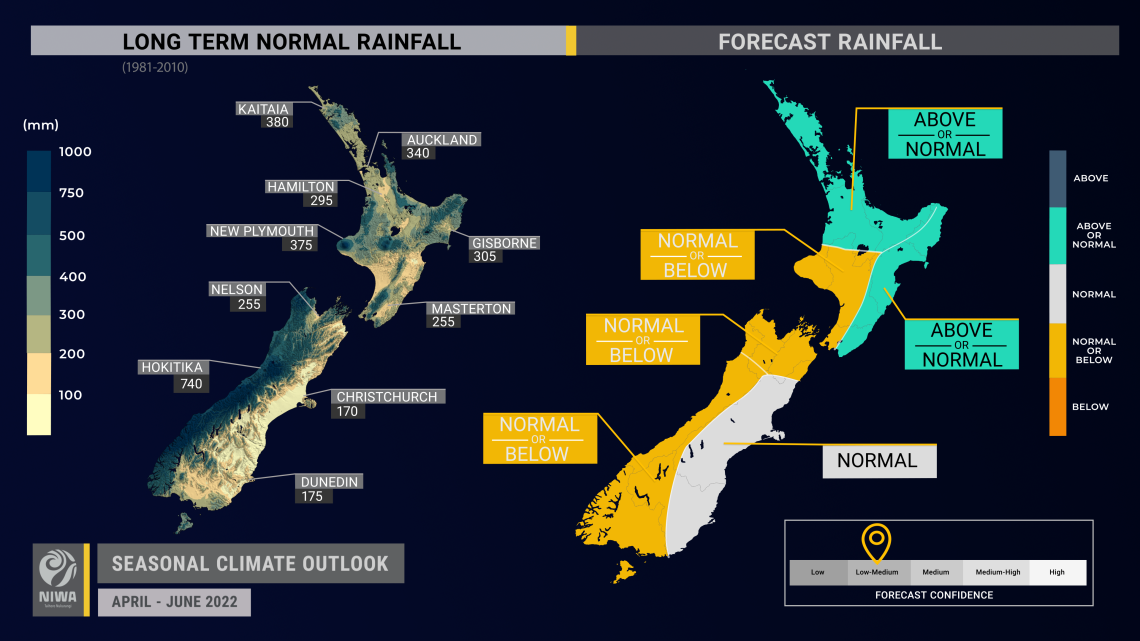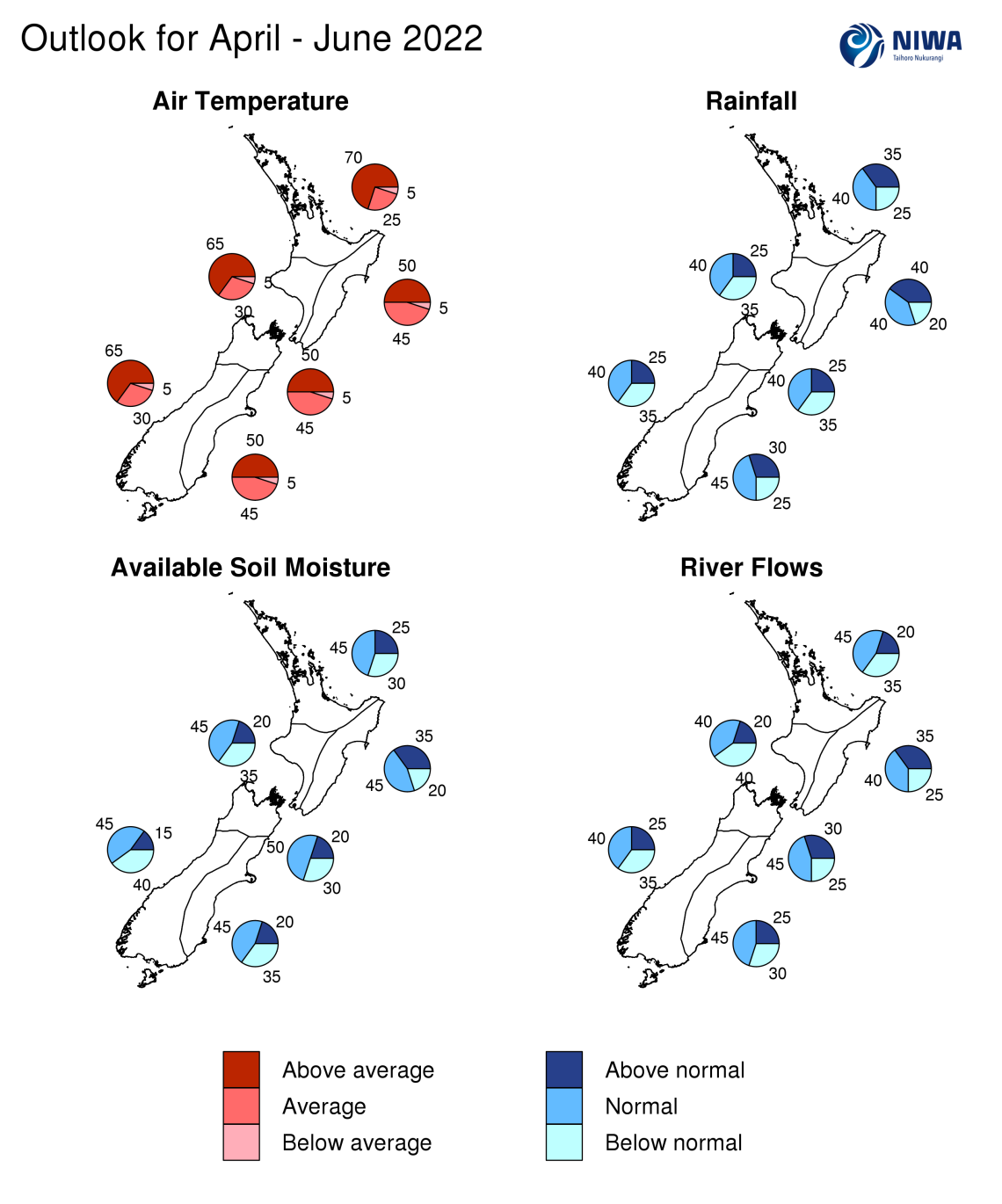Outlook Summary
- La Niña conditions are forecast to continue over the next three months (65% chance).
- Air pressure is forecast to be higher than normal to the east of the country and lower than normal to the northwest, causing more easterly quarter winds than normal.
- Rainfall is about equally likely to be near normal or below normal in the west of the North Island and north and west of the South Island, near or above normal in the north and east of the North Island, and most likely to be near normal in the east of the South Island.
- Seasonal rainfall may be influenced by a risk for ex-tropical cyclone activity or atmospheric rivers around New Zealand during the first half of April and again in early-to-mid May. These systems can cause heavy rainfall and flooding.
- Temperatures are very likely to be warmer than average in the north and west of the North Island and about equally likely to be near average or above average elsewhere.
- Marine heatwave (MHW) conditions continue offshore of all regions except the east of the North Island. This is expected to continue to influence periods of above average temperatures and delay the seasonal transition to cooler temperatures and frosts.
- Around the country, sea surface temperatures (SSTs) ranged from 0.3˚C to 3.3˚C above average during March. A severe marine heatwave developed in the western South Island with the largest SST anomaly in at least the last four decades.
- Soil moisture levels are about equally likely to be near normal or below normal in the west of the South Island and most likely to be near normal in all other regions.
- River flows are about equally likely to be near normal or above normal in the east of the North Island, near normal or below normal in the west of both islands, and most likely to be near normal in all other regions.
Regional predictions for April – June 2022
Northland, Auckland, Waikato, Bay of Plenty
The table below shows the probabilities (or percent chances) for each of three categories: above average, near average, and below average. In the absence of any forecast guidance there would be an equal likelihood (33% chance) of the outcome being in any one of the three categories. Forecast information from local and global guidance models is used to indicate the deviation from equal chance expected for the coming three-month period, with the following outcomes the most likely (but not certain) for this region:
- Temperatures are very likely to be above average (70% chance). Marine heatwave conditions will likely continue to influence periods of above average temperatures and delay the seasonal transition to cooler temperatures.
- Rainfall totals are about equally likely to be near normal (40% chance) or above normal (35% chance). There is an elevated chance for an atmospheric river or ex-tropical cyclone activity during the first half of April and again in early-to-mid May.
- Soil moisture levels and river flows are most likely to be near normal (45% chance).
The full probability breakdown is:
|
Temperature |
Rainfall |
Soil moisture |
River flows | |
|
Above average |
70 |
35 |
25 |
20 |
|
Near average |
25 |
40 |
45 |
45 |
|
Below average |
05 |
25 |
30 |
35 |
Central North Island, Taranaki, Whanganui, Manawatu, Wellington
Probabilities are assigned in three categories: above average, near average, and below average.
- Temperatures are very likely to be above average (65% chance). Marine heatwave conditions will likely continue to influence periods of above average temperatures and delay the seasonal transition to cooler temperatures.
- Rainfall is about equally likely to be normal (40% chance) or below normal (35% chance).
- Soil moisture levels are most likely to be near normal (45% chance) while and river flows are equally likely to be near normal (40% chance) or below normal (40% chance).
The full probability breakdown is:
|
Temperature |
Rainfall |
Soil moisture |
River flows | |
|
Above average |
65 |
25 |
20 |
20 |
|
Near average |
30 |
40 |
45 |
40 |
|
Below average |
05 |
35 |
35 |
40 |
Gisborne, Hawke’s Bay, Wairarapa
Probabilities are assigned in three categories: above average, near average, and below average.
- Temperatures are about equally likely to be above average (50% chance) or near average (45% chance).
- Rainfall totals are equally likely to be near normal or above normal (40% chance each). There is an elevated chance for an atmospheric river or ex-tropical cyclone activity during the first half of April and again in early-to-mid May.
- Soil moisture levels are most likely to be near normal (45% chance) while river flows are about equally likely to be near normal (40% chance) or above normal (35% chance).
The full probability breakdown is:
|
Temperature |
Rainfall |
Soil moisture |
River flows | |
|
Above average |
50 |
40 |
35 |
35 |
|
Near average |
45 |
40 |
45 |
40 |
|
Below average |
05 |
20 |
20 |
25 |
Tasman, Nelson, Marlborough, Buller
Probabilities are assigned in three categories: above average, near average, and below average.
- Temperatures are about equally likely to be above average (50% chance) or near average (45% chance).
- Rainfall is about equally likely to be normal (40% chance) or below normal (35% chance).
- Soil moisture levels and river flows are most likely to be near normal (45-50% chance).
The full probability breakdown is:
|
Temperature |
Rainfall |
Soil moisture |
River flows | |
|
Above average |
50 |
25 |
20 |
30 |
|
Near average |
45 |
40 |
50 |
45 |
|
Below average |
05 |
35 |
30 |
25 |
West Coast, Alps and foothills, inland Otago, Southland
Probabilities are assigned in three categories: above average, near average, and below average.
- Temperatures are very likely to be above average (65% chance). Marine heatwave conditions will likely continue to influence periods of above average temperatures and delay the seasonal transition to cooler temperatures.
- Rainfall totals are about equally likely to be near normal (40% chance) or below normal (35% chance). Continued patterns of high pressure near the South Island may contribute to a reduction in the typical westerly winds, Tasman Sea low pressure systems, and increase the chance for longer than normal dry spells.
- In late March, extremely dry to meteorological drought conditions were occurring in southern Southland and Stewart Island/Rakiura according to NIWA’s New Zealand Drought Index.
- During March, Lake Te Anau recorded its lowest inflow since records began in 1926.
- Soil moisture levels and river flows are about equally likely to be near normal (40-45% chance) or below normal (35-40% chance).
The full probability breakdown is:
|
Temperature |
Rainfall |
Soil moisture |
River flows | |
|
Above average |
65 |
25 |
15 |
25 |
|
Near average |
30 |
40 |
45 |
40 |
|
Below average |
05 |
35 |
40 |
35 |
Coastal Canterbury, east Otago
Probabilities are assigned in three categories: above average, near average, and below average.
- Temperatures are about equally likely to be above average (50% chance) or near average (45% chance).
- Rainfall totals are most likely to be near normal (45% chance). Frequent onshore wind flows may contribute to more days with light rain, drizzle, and cloud.
- Soil moisture levels and river flows are most likely to be near normal (45% chance).
The full probability breakdown is:
|
Temperature |
Rainfall |
Soil moisture |
River flows | |
|
Above average |
50 |
30 |
20 |
25 |
|
Near average |
45 |
45 |
45 |
45 |
|
Below average |
05 |
25 |
35 |
30 |
Graphical representation of the regional probabilities
Background
The NINO3.4 Index anomaly (in the central Pacific) over the last month (through 27 March) was -0.79˚C, near the La Niña threshold. The March monthly Southern Oscillation Index (SOI) was +1.5, well within the La Niña range.
In the subsurface equatorial Pacific, the warm pool that was present during February surfaced in the east during March. Cooler subsurface waters redeveloped in the central and west. As a result, upper-oceanic heat content decreased substantially in the central and western Pacific but continued to increase in the east. The overall signature was reflective of a central Pacific La Niña.
Importantly, trade winds across the central and western equatorial Pacific were stronger than normal during March, preventing the La Niña event from weakening.
Trades were weaker than normal in the east, allowing for the development of an area of warmer than average ocean water off the coast of Ecuador. Stronger than normal trades are expected to continue in the central and west during April with reduced trades or westerlies in the east, reinforcing the current pattern.
This now means that La Niña conditions are favoured to continue during April-June (65% chance). Between July-September, there is a 50% chance for El Niño Southern Oscillation Neutral (ENSO) neutral conditions and a 40% chance for La Niña. During October-December, ENSO neutral and La Niña are about equally likely at a 35-40% chance each. Since 1950, there have only been two other “triple-dip” La Niña events: 1998-2000 and 1973-1975.
During March, convective forcing focused over the eastern Indian Ocean, Maritime Continent, and western Pacific, like it did during February. Supressed convection was favoured over the eastern Pacific, consistent with the continuation of La Niña.
During the first two to three weeks of April, the Madden-Julian Oscillation (MJO) will be active in the central and eastern Pacific, focusing over the region of warm SSTs off the coast of Ecuador and over northern South America (resemblant of phase 8). This may promote a pattern that is favourable to tropical cyclone development in the Southwest Pacific and could influence New Zealand’s weather patterns. Historically, phase 8 has been associated with lower than normal air pressure and unsettled conditions in the New Zealand region.
During late April, convective forcing may re-emerge over the Indian Ocean and Maritime Continent (phases 3-4). Historically, phase 3 favoured high pressure over New Zealand and drier than normal conditions. Phase 4 favoured drier conditions in the North Island and eastern South Island with wetter weather in the west. Phases 3 and 4 also favoured warmer than average temperatures. The MJO may return to the phase 8 area by mid-May, historically associated with lower air pressure and wetter conditions in the west of both islands.
The Southern Annular Mode (SAM) displayed a bit more variability during March than in recent months, although it still spent more time in its positive phase. Some variability is likely during April, although the SAM will still likely spend more time in its positive phase than negative phase, likely continuing to limit the number of southerly fronts.
New Zealand’s coastal water temperatures remained above average during March, with the western South Island posting its largest monthly anomaly in at least the last four decades (since at least September 1981). This would also become the largest monthly SST anomaly observed in any of the country’s six climate regions. At the end of March, marine heatwave (MHW) conditions were occurring offshore of all regions of the country except the eastern North Island. Model guidance continues to suggest the persistence of warmer than average coastal waters through the rest of autumn into winter, consistent with the continuation of La Niña-like conditions. Warmer than average coastal sea temperatures will likely delay the seasonal transition to cooler temperatures around the country. Enhanced baroclinicity in the New Zealand region, as a result of southerly air masses clashing with the remnant MHW, may result in more frequent cyclogenesis, or developing low pressure and unsettled weather in the coming months.
NZ coastal SST anomalies (through 29 March)
|
North NI |
1.39˚C |
|
West NI |
1.02˚C |
|
East NI |
0.30˚C |
|
North SI |
1.48˚C |
|
West SI |
3.25˚C |
|
East SI |
1.32˚C |
Forecast Confidence
Temperature
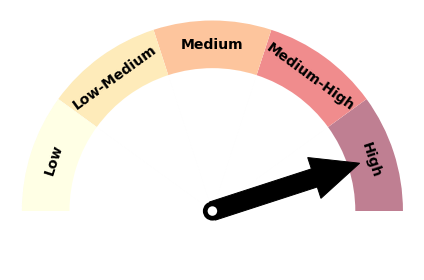
|
Forecast confidence for temperatures is high. The continuation of marine heatwave and La Niña conditions is expected to have an upward influence on air temperatures, delaying the seasonal transition to cooler temperatures. Most of the climate models that NIWA surveys indicate a warmer than average April-June. |
Rainfall
|
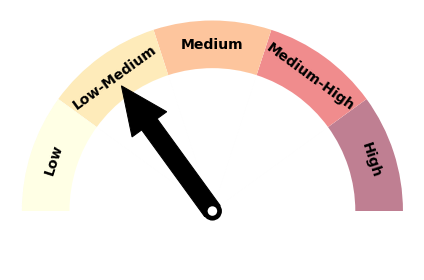
|
Forecast confidence for rainfall is low to medium. With rainfall patterns still likely being influenced by tropical cyclone activity and atmospheric rivers, there is more uncertainty than normal. Overall, the country should continue to remain prepared for extremes – both on the wet and dry sides of the meteorological spectrum. |

